Essential Guide to Plant Transplant Tools


Intro
The evolution of horticulture and agriculture hinges largely on the tools employed in the various processes, especially during plant transplantation. Proper transplanting ensures not only the survival of plants but also their thriving growth in new environments. Selecting the appropriate tools can significantly influence the overall success of transplanting. In this guide, we will investigate the different tools utilized in plant transplantation, understanding their importance, variations, and how they contribute to sustainable practices in gardening and cultivating.
Research Overview
In understanding plant transplant tools, it is crucial to explore their function, design, and impact on plant health. These tools encompass a variety of implements, from simple hand-held devices to advanced machinery designed for large-scale agriculture.
Methodological Approaches
Research in this area is multifaceted. It may involve observational studies that assess the effectiveness of various tools in different soil types and environmental conditions. In addition to qualitative analyses, data might include quantitative measurements of transplant success rates, plant growth metrics, and recovery times after transplantation. Exploring peer-reviewed journals provides insights into the effectiveness of traditional tools like trowels and spades in contrast to newly developed transplant systems.
Significance and Implications
Understanding transplant tools is indispensable for both novice and expert gardeners. Knowledge about these tools leads to better decision-making, ultimately improving sustainability in horticulture. Effective transplanting minimizes stress on plants, enhancing their resilience to diseases and pests while promoting healthier ecosystems. As the demand for sustainable practices grows, tools that advocate for minimally invasive transplantation are starting to gain popularity.
Current Trends in Science
The field of plant transplant tools is constantly evolving, thanks to technological advancements and a growing emphasis on sustainable practices.
Innovative Techniques and Tools
Many modern techniques focus on increasing efficiency and minimizing plant shock during relocation. For example, tools featuring ergonomic designs reduce strain on the body while enhancing precision in digging and planting. Innovations such as automatic potting machines and soil moisture sensors are making substantial differences in large-scale operations. It's essential to remain informed about trending tools like the RootMaker® system which promotes healthier root systems.
Interdisciplinary Connections
The study of transplant tools does not exist in isolation. There is a rich interplay between botany, engineering, and environmental science that fuels innovation in this domain. Collaboration among scientists, engineers, and farmers leads to the development of tools that are not only effective but also environmentally sustainable. Comprehensive understanding benefits from disciplines that address soil health, climate adaptation, and agricultural technology.
"The right tools can make a world of difference in plant survival rates and ecosystem health".
This essential guide aims to shed light on the array of transplant tools available, their respective uses, maintenance practices, and the latest in transplant technology. Each tool has its unique function and purpose, making it necessary for users to educate themselves for optimal outcomes.
Prelims to Plant Transplant Tools
Plant transplant tools play a crucial role in horticulture and agriculture. Understanding these tools is essential for both novice gardeners and seasoned professionals alike. The right tool allows for efficient and effective planting, which in turn influences the overall health of the plants. This section analyzes the various facets of plant transplant tools, their definitions, historical significance, and their relevance in current gardening practices.
Definition and Importance
Plant transplant tools are instruments specifically designed for transferring plants from one location to another, ensuring minimal disruption to their root systems. These tools include shovels, trowels, and other devices that assist in digging, lifting, and placing plants into new soil environments. The importance of these tools cannot be overstated. Proper transplanting improves plant survival rates, helps in establishing a robust root system, and supports the growth of healthy foliage.
In addition, having the correct tool mitigates the risk of damaging delicate roots, which can significantly affect plant vigor. Efficient working processes allow gardeners to carry out tasks swiftly, thereby conserving time and reducing physical strain.
Brief History of Plant Transplanting Practices
Historically, the practice of transplanting has roots that trace back to ancient civilizations. Cultures recognized the importance of moving plants to optimize growing conditions. Early forms of transplanting utilized basic tools fashioned from stone or wood. Over centuries, techniques and tools evolved.
In the 18th and 19th centuries, mechanization began to play a role in agriculture, impacting how transplanting was approached. The introduction of metal tools allowed gardeners to perform their tasks with greater precision. Today, modern transplanting explores innovations such as automated solutions and eco-friendly materials that resonate with contemporary sustainability goals.
Through time, the evolution of plant transplant tools reflects humanity's growing understanding of botany and the intricate needs of various plants. In essence, appreciating this history sheds light on not only how practices have changed but also the growing importance of these tools in ensuring a sustainable and thriving environment.
Types of Plant Transplant Tools
The choice of transplant tools significantly affects the success of planting endeavors. Each tool serves a specific purpose, contributing to the overall health and development of plants. Knowing the various types of tools available can assist gardeners in making informed decisions based on their specific needs and gardening practices.
Standard Transplanting Tools
Standard transplanting tools are the backbone of any gardener's toolkit. They include essential implements that help in preparing soil, digging holes, and moving plants.
Shovels
Shovels are versatile tools that excel at moving bulk soil and digging large holes. Their long handles and broad blades provide the leverage needed for effective soil displacement. A key characteristic of shovels is their ability to tackle tougher soil conditions.
They are a popular choice for many gardeners and landscapers, particularly when it comes to bed preparation. However, shovels can be cumbersome in tight spots, making them less effective for delicate transplanting tasks.
One unique feature of certain shovels is their pointed tips, which allow them to penetrate harder, compacted soils more easily. This feature can be advantageous when working in areas where the top layer of soil is rocky or dense.
Trowels
Trowels are essential tools for any transplanting task. They are smaller than shovels and are ideal for digging and planting in narrow spaces. A trowel's size makes it a beneficial tool for transplanting seedlings or smaller plants.
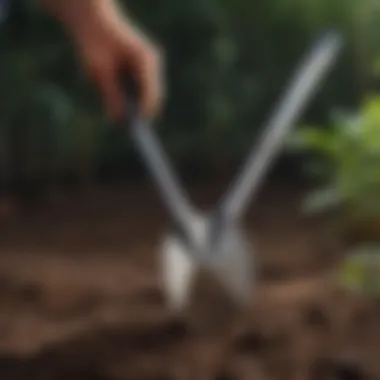
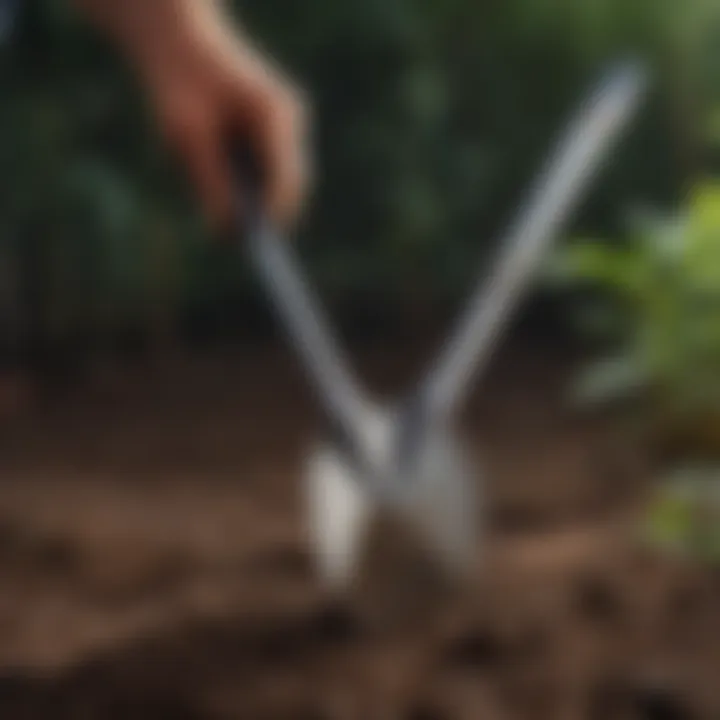
Their pointed blades and comfortable handles allow for precision work, making trowels a popular choice among gardeners who value accuracy. One of the unique features of a trowel is its ability to create defined planting holes without disturbing surrounding soil too much.
However, the disadvantage of trowels lies in their limited capacity for bulk digging. While they are excellent for smaller tasks, trowels might not suffice when larger excavations are required.
Spades
Spades are similar to shovels but generally feature a flat blade. They are particularly effective at slicing through soil and are great for edging and lifting plants. A notable characteristic of spades is their vertical blade design, which allows for easier slicing and transferring of soil.
They are a favored tool for defining garden beds or areas, as well as for digging deeper or narrow holes. Spades can also come in handy when dividing perennials or moving larger root balls.
One downside to spades is that they require more physical exertion when compared to some other tools. Their flat blades may also struggle in tougher soil unless enough force is applied.
Specialized Transplant Tools
Specialized transplant tools cater to specific transplanting needs and tasks. They enhance the effectiveness of the standard tools, ensuring that plant transplantation is performed with skill and care.
Root Pruners
Root pruners are designed specifically for cutting roots during transplanting. They have sharp, curved blades that allow for clean cuts without damaging the plant. This is crucial for maintaining plant health during the transplantation process.
The key characteristic of root pruners is their precision, which helps prevent tearing roots in tight spaces. Their design encourages healthy root regeneration, making them a beneficial choice for those focused on plant vitality. One unique feature is the ability to reach into deeply nested roots, which some other tools may not access.
However, root pruners are best used for smaller plants or delicate root systems. They may be less effective for larger trees or shrubs.
Bulb Planters
Bulb planters simplify the process of planting bulbs and small plants. With a narrow, hollow tube design, they allow users to easily insert bulbs into the ground. The tool's design is advantageous for ensuring that bulbs are planted at the correct depth without excessive soil disturbance.
A key benefit of bulb planters is their time efficiency, especially when planting a larger number of bulbs in a row. However, they are generally not suitable for planting larger plants or performing broader soil tasks.
One unique feature of bulb planters is their plunger mechanism that removes soil cores quickly. Despite this efficiency, users must be aware of soil conditions, as rocky or overly compacted soil can hinder functionality.
Transplanting Forks
Transplanting forks are specialized tools designed to lift and separate plants without causing undue stress. They feature sharp tines that can create space in packed soil while minimizing root disturbance. A notable aspect of transplanting forks is their ability to easily navigate around existing plant roots.
Transplanting forks are beneficial for gardeners needing to move perennials or larger plants. The unique feature lies in their ability to break up the soil, promoting healthy root systems upon transplantation. However, they may not be suitable for very compact or hard ground.
Tools for Container Gardening
Container gardening has its own set of unique requirements. The tools designed for this style of gardening help optimize the use of space and resources.
Handheld Transplanters
Handheld transplanters are compact tools ideal for moving plants from pots to garden beds. Their small size makes them suitable for delicate seedlings or small plants. They typically feature a narrow blade and are easy to maneuver.
A key characteristic of handheld transplanters is their portability, allowing users to work efficiently in confined spaces. However, their limited size can pose challenges when dealing with larger plants.
Their unique feature includes the ability to crop plants at the base, promoting quicker repotting. Yet, users must be cautious, as improper use can potentially damage roots.
Soft Trowels
Soft trowels are specifically designed for working with delicate soil systems in container gardening. They usually have flexible blades, making them easier to use without damaging tender roots. A significant benefit of soft trowels is their ability to maneuver in various soil types.
They are popular among gardeners, particularly those who work with fragile seedlings. However, their softness can reduce efficacy when working in tougher soil conditions, limiting their versatility.
Seedling Trays
Seedling trays provide a structured method for germinating seeds. They feature divided compartments that allow for organization and optimal growing conditions for individual seedlings. A critical aspect of seedling trays is that they promote healthy root growth and ease of transplanting.
They are a beneficial choice for those who need to manage a larger number of seedlings efficiently. Their unique feature is the drainage design, allowing excess water to escape, which reduces the risk of overwatering. However, issues can arise from using them in excessive sunlight, which can lead to rapid drying.
Selecting the Right Plant Transplant Tool
Choosing the correct plant transplant tool is crucial for every gardener, whether novice or expert. The right tool enables efficient and effective plant transplantation, which directly affects plant health and growth. In horticulture and agriculture, employing the appropriate tools can save time, reduce physical strain, and improve results.
Assessing Plant Types
Understanding the specific needs of various plant types is fundamental when selecting transplant tools. Different species vary significantly in their root structures, sizes, and growth habits. For instance, delicate seedlings typically benefit from tools designed for gentle handling, while larger perennials may require sturdier implements.
Some critical questions to consider include:
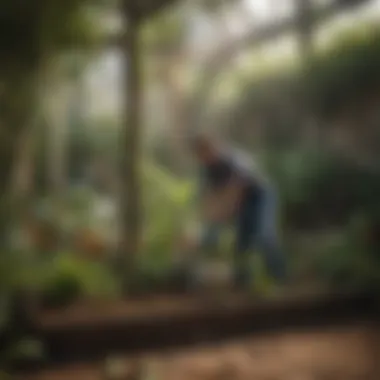
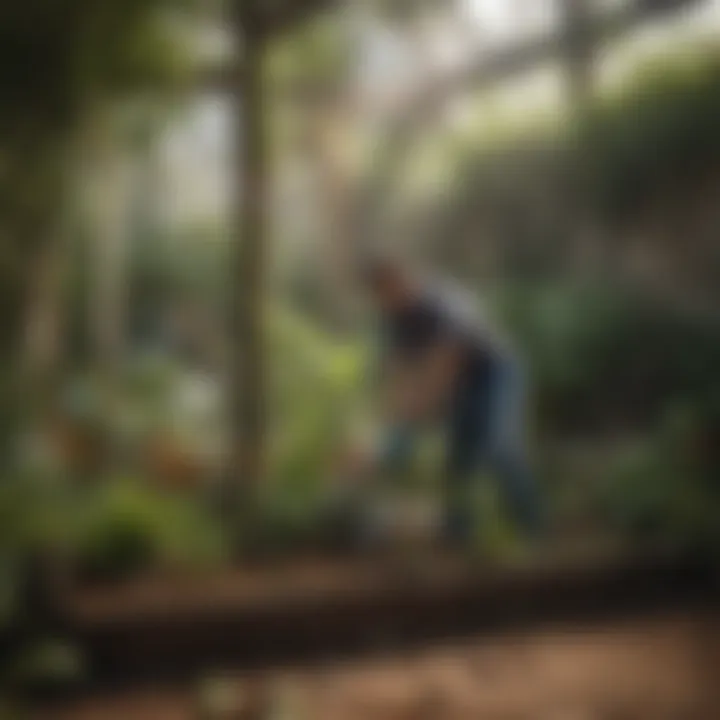
- What is the root depth of the plant?
- Are the roots fibrous or taproot?
- What is the overall size of the plant?
For herbaceous plants, handheld transplanters are effective. However, for larger shrubs or small trees, a spade may be more suitable. Tools like root pruners can be beneficial for more specialized needs, especially if you aim to manage the root structure effectively during the transplanting process.
Evaluating Soil Conditions
Soil type plays a significant role in determining the necessary transplant tools. Different soils—such as sandy, clayey, or loamy—require different approaches. Knowing the soil's consistency and moisture level will guide tool selection. For example, compacted soils might need a digging fork or a sturdy spade to break through resistant layers. Here, a well-structured approach is key:
- Dry soil requires tools that can penetrate deeper and handle the resistance, like trowels and spades.
- Wet soil may need a more delicate approach, with tools that minimize damage, such as soft trowels.
- Rocky or hard soil could necessitate a transplanting fork or specialized tools designed to break through the material.
Thorough knowledge of soil conditions helps in selecting appropriate tools, reducing transplant shock, and improving survival rates of transplanted flora.
Considering User Comfort and Ergonomics
User comfort during transplantation cannot be underestimated. Ergonomically designed tools aid in reducing strain on the back, hands, and wrists. Tools that fit well in hand and are proportional to body size can enhance efficiency. While selecting tools, it is vital to consider:
- Handle Design: Long handles can help in reaching deeper without bending over.
- Weight of the Tool: Lighter tools are often easier to manage, especially for prolonged use.
- Grip Quality: Look for tools with rubberized grips or those that are specially contoured for better handling.
Investing in ergonomic tools not only makes the task more straightforward but also supports consistent use over time, leading to better gardening practices. Identifying the right transplant tool is not only about functionality but also about enhancing the entire experience of planting.
"Selecting the right plant transplant tool is as important as the planting itself. Tools are not just instruments; they are part of the gardening journey."
Understanding these considerations plays a fundamental role in ensuring successful transplantation practices.
Techniques for Successful Plant Transplantation
Successful plant transplantation is integral to both home gardening and agriculture. Mastery of transplant techniques can significantly affect plant growth and overall health. This section provides a comprehensive framework for the specific actions that enhance the success rate during plant transplantation. Key factors include timing, soil preparation, and post-transplant care, each of which contribute to nurturing plants effectively after transplanting.
Timing for Transplantation
The timing of transplantation is critical. Understanding when to transfer plants can prevent transplant shock, which is a common issue where plants struggle to adapt to their new environment. Certain periods within the year are more favorable, depending on plant species and local climate conditions.
Seasonal Considerations
Seasonal considerations are perhaps the most relevant factors in the plant transplantation process. Different plants thrive under specific seasonal conditions. Generally, spring is the preferred time as it aligns with the natural growing cycle.
- Key characteristics of seasonal considerations include:
- Temperature Regulation: Warm soil promotes root activity.
- Water Availability: Maximizing the natural rainfall reduces the need for additional watering.
These aspects make spring a beneficial season for transplanting. However, some plants, like fall bloomers, benefit from being transplanted in the autumn, taking advantage of cooler temperatures to establish roots before winter. Some disadvantages could be potential risks of frost in late fall, which can harm young transplants.
Growth Stages
Another fundamental aspect of transplant timing involves the growth stages of the plants being moved. Transplanting at the right growth stage ensures a smoother transition and better establishment in the new environment.
- Key characteristics of growth stages include:
- Juvenile Stage: Plants in this stage usually adapt better to transplanting as they are resilient and active in growth.
- Established Stage: While stronger, older plants may face more stress and require more careful handling.
Transplanting during the juvenile stage often yields better outcomes. While risks at later stages can be higher, it requires more experience to ensure a successful transfer, which may not be manageable for novice gardeners.
Soil Preparation Techniques
Soil plays a pivotal role in plant transplantation. Proper soil preparation ensures that the transplant has adequate nutrients and a healthy environment to thrive. Techniques include:
- Testing Soil pH: This determines the acidity and alkalinity, impacting nutrient availability.
- Amending Soil: Adding compost or other organic matter can improve soil structure and fertility.
- Loosening Compacted Soil: Aerating the soil allows roots to penetrate easily and access necessary nutrients.
These prepared conditions facilitate a more successful transplant, reducing the chances of root diseases or stress.
Post-Transplant Care
Once plants are in their new homes, post-transplant care is vital for their establishment and growth. Effective care involves watering, nutrient management, and monitoring the plant’s recovery.
Watering Strategies
Watering strategies are essential in post-transplant care. Correct watering practices can mean the difference between survival and failure for a newly transplanted plant.
- Key characteristics of watering strategies include:
- Consistent Moisture: Ensuring the soil remains moist but not waterlogged helps roots acclimate quickly.
- Deep Watering Practices: Encouraging roots to grow deeper into the soil profile rather than staying near the surface.
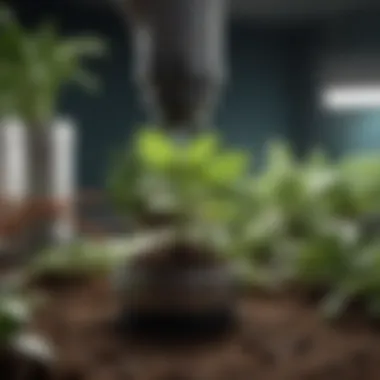
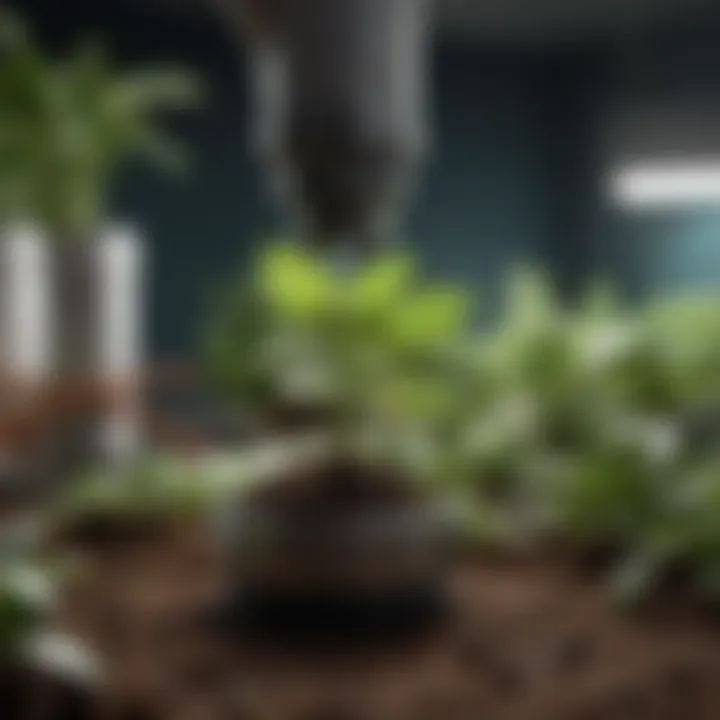
This method tends to be beneficial, as it promotes a strong root system. Overwatering, however, can lead to root rot and other complications.
Nutrient Management
Nutrient management is also crucial after transplanting. Delivering the right fertilizers at the right time supports recovery and growth.
- Key characteristics of nutrient management include:
- Slow-Release Fertilizers: These provide nutrients over time, aligning with the plant’s needs.
- Avoiding Chemical Burn: Gradually introducing fertilizers to prevent stress on the young plant.
Utilizing nutrient management can promote healthy growth, though care must be taken not to over-fertilize, which could hurt the plants.
In summary, mastering the techniques of timing, soil preparation, and post-transplant care is essential for successful plant transplantation. Proper execution of these techniques enhances plant resilience while promoting healthy growth.
Maintenance of Plant Transplant Tools
Proper maintenance of plant transplant tools is paramount for both their functionality and longevity. Without regular upkeep, tools can become dull, corroded, or otherwise ineffective, which can negatively impact the success of transplantation efforts. Given that these tools are essential for promoting plant health in horticulture and agriculture, understanding how to care for them is necessary for every gardener and professional.
Cleaning Techniques
Maintenance starts with cleaning. After each use, tools should be cleaned of soil, sap, and other residues. Use a stiff brush to remove dirt without damaging the surfaces. A solution of warm soapy water can further assist in loosening stubborn grime. Rinsing tools under running water can eliminate soap residue, but care should be taken to avoid excessive exposure to water, as this can lead to rusting.
- Tools requiring special attention:
- Shovels and spades: Pay attention to the blade, as soil can get lodged in the edges.
- Trowels: Ensure no residue remains on the handle.
- Forks: Use a brush to clear out soil stuck between the tines.
Drying the tools immediately after washing is crucial. This can be done using a cloth or simply air drying in a shaded area.
Sharpening and Preservation
Sharpening tools is another important aspect of maintenance. A sharp blade performs better and is less likely to cause damage to plants during transplantation. Use a file or sharpening stone to maintain the edge of cutting tools like pruners or trowels. It is advisable to sharpen the tool after every few uses or as needed.
- Preservation Techniques:
- Store in a dry place: Moisture can lead to rust and deterioration.
- Apply oil: Using a light coat of mineral oil can help prevent rust on metal parts.
- Use protective sheaths: For sharp tools, a sheath can prevent accidental cuts and maintain the sharp edge.
Regular maintenance not only extends the life of tools but also ensures optimal performance during critical gardening tasks.
Innovations in Plant Transplant Technology
Innovations in plant transplant technology represent a significant advancement in horticulture, marrying efficiency with sustainability. As the world faces challenges such as climate change and resource depletion, these innovations play a crucial role in enhancing the effectiveness of plant transplantation. By understanding the latest developments, cultivators can choose tools that not only improve their processes but also contribute to better environmental practices. This section will cover two key areas of innovation: automated transplanting solutions and eco-friendly materials in design.
Automated Transplanting Solutions
Automated transplanting solutions provide a remarkable leap in how plants are moved from one location to another. Robotics and AI technology have made it possible to mechanize the transplanting process. This efficiency leads to significant labor savings, allowing farmers and gardeners to focus on other critical tasks. Some benefits of these solutions include:
- Precision planting: Automated systems can ensure that each plant is placed at the ideal depth and spacing, which can enhance growth potential and overall yield.
- Reduced labor costs: Automated solutions can reduce the number of workers needed for transplanting, cutting down on expenses related to labor.
- Consistency: Technology ensures that every plant is transplanted in the same manner, resulting in more uniform growth and harvests.
Organizations and researchers are continually enhancing these machines to adapt to various planting conditions and types of plants. Moreover, many automated systems now come equipped with feedback loops to monitor plant health, contributing to more responsive growing environments.
Eco-Friendly Materials and Designs
The push for sustainability has brought about innovations in the materials and designs used for transplant tools. Traditional tools may rely on plastics or metals that can harm the environment. However, newer designs utilize biodegradable materials or sustainable resources. Consider the following aspects:
- Biodegradable materials: Tools made from plant-based plastics or compostable substances can reduce waste and support a circular economy.
- Sustainable sourcing: Many tools now incorporate responsibly sourced wood or metal that has minimal environmental impact.
- Design for longevity: Innovations focus not only on creating tools that are environmentally sound but also on those that are durable, meaning less frequent replacements are needed.
By aligning tool development with eco-friendly practices, the horticulture industry reduces its overall carbon footprint while promoting sustainable agriculture. This shift not only benefits the environment but also appeals to a growing base of environmentally conscious consumers.
"Sustainability and efficiency go hand in hand in today's horticultural practices. Embracing innovation is not merely a choice; it is a necessity for future growth."
As these technologies continue to progress, they will reshape how we approach plant transplantation, making the process more efficient, sustainable, and aligned with modern concerns about our planet's health.
Ending
The conclusion of this article underscored the integral role that plant transplant tools play in effective horticulture and agriculture. A proper selection of these tools is not a mere preference but a necessity that can influence the success of plant growth and overall garden health. A suitable tool tailored for specific transplantation tasks can significantly enhance efficiency and reduce strain on the user.
Recap of Essential Information
In reviewing the fundamental aspects covered, it is clear that knowledge about the various types of transplant tools is crucial for anyone engaged in gardening. Standard tools, such as shovels and trowels, serve the basic needs of simple planting. Meanwhile, specialized options like root pruners and transplanting forks address specific challenges that may arise during plant relocation. Furthermore, understanding soil condition and user comfort ensures that the right tools are chosen, promoting a more pleasant gardening experience.
A focus on maintenance, including cleaning and preservation, ensures longevity of the tools. Innovations, such as automated transplanting solutions, points towards a future where technology further aids efficient gardening. Overall, the details summarized here provide a framework that can substantially benefit both novice and experienced gardeners.
Final Thoughts on Plant Transplant Tools
As we ponder on the contents of this article, it is evident that selecting the right plant transplant tools is more than just a minor decision in the planting process. It involves a consideration of plant variety, soil conditions, and personal ergonomics. The advancements in transplant technology not only promise improved practices but also invite a reflection on sustainable gardening methods. This insights serve as a reminder that embracing suitable tools enhances not only garden productivity but also enriches the overall gardening experience, fostering a deeper connection with the natural environment.
Selecting the right plant transplant tools is essential for sustainable gardening and contributes to long-term plant health.



